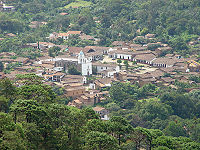
Photo from wikipedia
espanolLa herbolaria y la medicina tradicional en Mexico son actividades persistentes en la poblacion, las cuales se abordan desde perspectivas diversas, aunque existen pocos reportes que mencionen su sustentabilidad. El… Click to show full abstract
espanolLa herbolaria y la medicina tradicional en Mexico son actividades persistentes en la poblacion, las cuales se abordan desde perspectivas diversas, aunque existen pocos reportes que mencionen su sustentabilidad. El objetivo del estudio fue identificar y documentar el conocimiento y practicas sustentables realizadas por los recolectores, productores y consumidores de plantas medicinales del oriente del estado de Mexico. La hipotesis fue que el conocimiento transmitido intergeneracionalmente ha llevado a una practica sustentable de la herbolaria. El metodo etnobotanico se utilizo para determinar la sustentabilidad del sistema. Entrevistas semiestructuradas se realizaron a actores claves que fueron adultos mayores, recolectores y productores de plantas medicinales. En la herbolaria local se identificaron 61 especies de plantas utilizadas, de las cuales 35 se recolectan o cultivan para su venta en el tianguis de Ozumba, estado de Mexico. Los adultos mayores usan las plantas locales y refirieron otras 26 especies diferentes, de las cuales cinco las adquieren en comercios naturistas, de las restantes (21), su utilidad principal no es la medicinal: seis son de ornato, 13 se usan en la cocina y dos se consideran perennes silvestres. La herbolaria sigue presente en el oriente del estado de Mexico, a traves de un intercambio proactivo entre el productor recolector y los adultos mayores, quienes adquieren las plantas locales de temporada y favorecen la conservacion de practicas agricolas amigables con el ambiente. La herbolaria es una practica sustentable gracias a los procesos de recoleccion y produccion. Aunque puede estar en riesgo debido a la perdida del conocimiento intergeneracional; ya que al disminuir la transmisibilidad se arriesga el futuro de la actividad. Otros riesgos detectados son economicos por los precios bajos de las plantas medicinales. EnglishHerbalism and traditional medicine in Mexico are persistent activities in the population, both address diverse perspectives, although there are few reports mentioning the sustainability of such activities. The objective of the study was to identify and document the knowledge and sustainable practices carried out by the collectors, producers and consumers of medicinal plants in the east of the state of Mexico. The hypothesis was that the knowledge transmitted intergenerationally has led to a sustainable practice of herbalism. The ethnobotanical method was used to determine the sustainability of the system. Semi-structured interviews were conducted with key actors who were older adults, collectors, and producers of medicinal plants. Plants of 61 species used were identified at the local herbalist market, 35 species are collected or grown for sale in the street market (tianguis) of Ozumba, state of Mexico. The older adults use the local plants and referred other 26 different species, of which five are acquired in naturalist stores, of the remaining (21), their main use is not medicinal: six are ornamental, 13 are used in cooking and two are considered wild perennials. Herbalism is still present in the east of the state of Mexico, through a proactive exchange between the harvesting producer and the elders, who acquire the local plants in season favoring the conservation of environmentally friendly agricultural practices. Herbalism is a sustainable practice thanks to the harvesting and production processes. Although it may be at risk due to the loss of intergenerational knowledge; as transmissibility decreases, the future of the activity is at risk. Other risks detected are of economic nature caused by the low prices of medicinal plants.
Journal Title: Agrociencia
Year Published: 2020
Link to full text (if available)
Share on Social Media: Sign Up to like & get
recommendations!